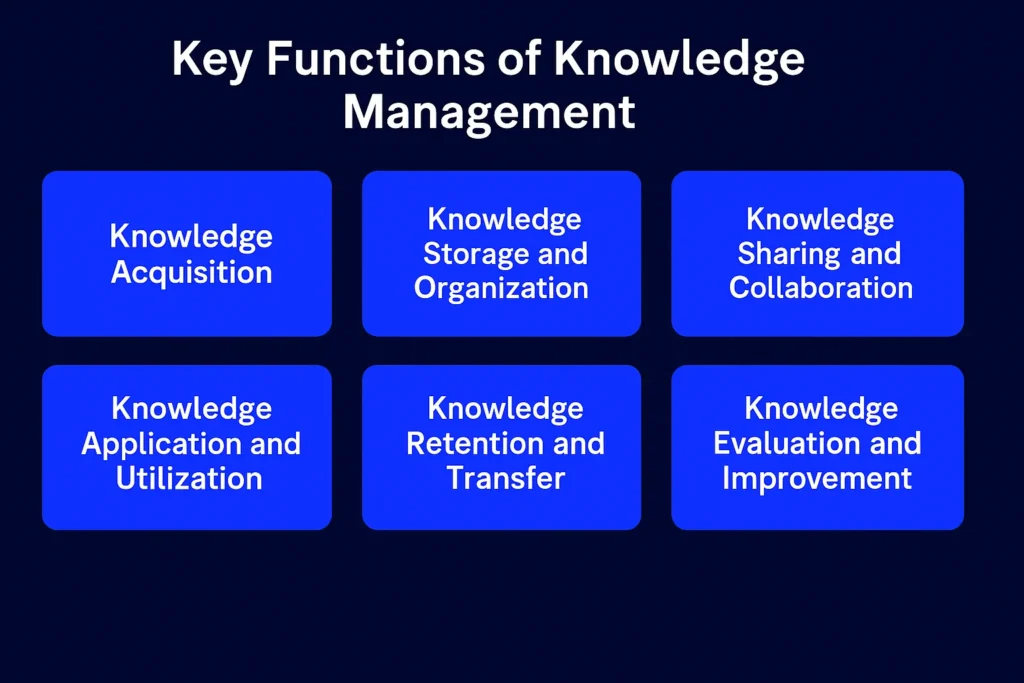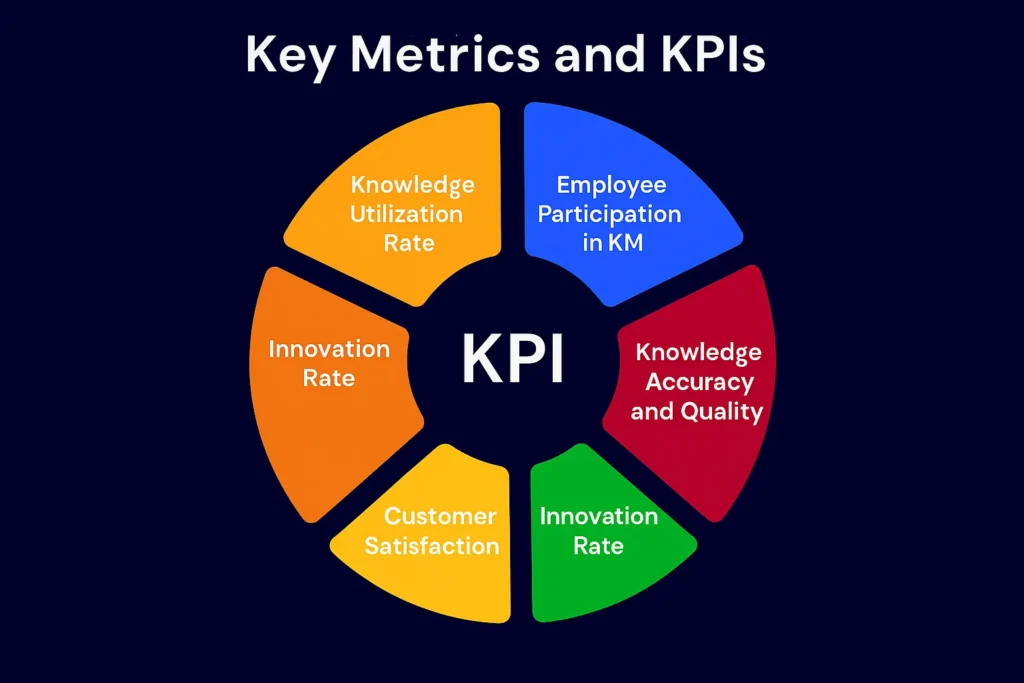
Executive Summary
Knowledge Management (KM) is the systematic process of creating, capturing, organizing, sharing, and utilizing an organization’s knowledge to improve efficiency, innovation, and decision-making.
It involves strategies, tools, and practices that enable organizations to leverage both explicit knowledge (documented information) and tacit knowledge (personal expertise) to gain a competitive advantage.
In today’s knowledge-driven economy, KM is a critical function for businesses, government agencies, healthcare institutions, educational organizations, and technology firms. This guide explores the concept, functions, types, strategies, benefits, challenges, and emerging trends in knowledge management.
Table of Content
Introduction
Organizations generate vast amounts of information daily, ranging from research reports and customer data to employee expertise and project insights. Without a structured approach, this knowledge can remain siloed, underutilized, or lost entirely.
KM is not limited to technology or databases—it encompasses organizational culture, collaboration, communication, and leadership practices that support knowledge sharing. Effective KM promotes innovation, improves productivity, enhances customer satisfaction, and enables informed decision-making.
Core Concepts of Knowledge Management
Knowledge Management integrates people, processes, and technology to optimize knowledge creation, storage, and usage. Key concepts include:
- Knowledge Creation – Developing new insights, ideas, and solutions through research, collaboration, and experience.
- Knowledge Capture – Documenting tacit and explicit knowledge in formats that are accessible and reusable.
- Knowledge Organization – Structuring and categorizing information for easy retrieval and understanding.
- Knowledge Sharing – Encouraging collaboration and communication to distribute knowledge across teams and departments.
- Knowledge Application – Using knowledge to improve processes, solve problems, and make informed decisions.
- Knowledge Retention – Ensuring critical knowledge is preserved, especially during employee turnover or organizational changes.
Types of Knowledge
Understanding the types of knowledge is essential for effective KM:
1. Explicit Knowledge
- Documented knowledge that is easily communicated and stored.
- Examples: manuals, databases, reports, policies, and research papers.
2. Tacit Knowledge
- Personal, experiential knowledge that is harder to formalize.
- Examples: problem-solving skills, expertise, judgment, and intuition.
3. Implicit Knowledge
- Knowledge that exists but is not yet fully documented or utilized.
- Often discovered through experience or analysis.
4. Embedded Knowledge
- Knowledge embedded in processes, products, or organizational routines.
- Examples: standard operating procedures, software code, and organizational culture.
Key Functions of Knowledge Management
Knowledge Management involves multiple interrelated functions:

1. Knowledge Acquisition
- Identifying valuable knowledge from internal and external sources.
- Techniques: research, interviews, surveys, and collaboration tools.
2. Knowledge Storage and Organization
- Using repositories, databases, and document management systems to store knowledge.
- Organizing knowledge with metadata, taxonomies, and indexing for easy retrieval.
3. Knowledge Sharing and Collaboration
- Facilitating communication through intranets, knowledge portals, wikis, and collaboration platforms.
- Encouraging team discussions, workshops, and knowledge-sharing events.
4. Knowledge Application and Utilization
- Ensuring knowledge is applied to solve problems, make decisions, and improve processes.
- Integrating KM into workflows, projects, and strategic planning.
5. Knowledge Retention and Transfer
- Capturing critical knowledge before employee turnover or project completion.
- Methods: mentoring programs, documentation, storytelling, and exit interviews.
6. Knowledge Evaluation and Improvement
- Assessing the effectiveness of KM practices and systems.
- Metrics: usage frequency, adoption rate, knowledge quality, and impact on decision-making.
Knowledge Management Strategies
Organizations implement KM strategies to align knowledge initiatives with business goals:
- Codification Strategy – Focuses on documenting and storing knowledge in accessible formats.
- Personalization Strategy – Encourages direct knowledge sharing between individuals through collaboration and mentoring.
- Communities of Practice (CoP) – Groups of employees sharing expertise, best practices, and insights around specific topics.
- Knowledge Networks – Leveraging internal and external networks to access and exchange knowledge.
- Learning Organization Approach – Embedding continuous learning and knowledge creation into organizational culture.
- Technology-Driven Strategy – Using advanced KM tools, AI, and analytics to manage and deliver knowledge efficiently.
- Integrated Knowledge Management – Aligning KM with business strategy, objectives, and workflows for maximum impact.
Benefits of Knowledge Management
- Enhanced Decision-Making – Access to accurate, relevant knowledge improves decision quality.
- Increased Innovation – Facilitates the generation and sharing of creative ideas.
- Operational Efficiency – Reduces duplication of effort and improves workflow.
- Knowledge Retention – Prevents loss of critical expertise during employee turnover.
- Improved Customer Service – Provides employees with knowledge to serve customers better.
- Competitive Advantage – Leveraging knowledge assets strengthens market positioning.
- Employee Development – Encourages learning, skill growth, and career advancement.
- Organizational Learning – Fosters a culture of continuous improvement and adaptation.
Related Topics to Explore
Knowledge management is deeply connected with several other management practices that enhance organizational learning and efficiency.
For a deeper understanding of how different management systems work together, explore these guides:
- What Is Business Management? – Learn how effective leadership and structured decision-making shape successful organizations.
- What Is Operations Management? – Discover how managing processes and systems supports knowledge-sharing within business operations.
- What Is Human Capital Management (HCM)? – See how people management contributes to better knowledge retention and collaboration.
- What Is Performance Management? – Understand how tracking and developing employee performance aligns with knowledge-based goals.
- What Is Management Consulting? – Explore how consultants use knowledge systems to guide strategic business improvements.
Tools and Technologies in Knowledge Management
Modern KM relies on a variety of tools and platforms:
- Knowledge Repositories – SharePoint, Confluence, Alfresco
- Collaboration Platforms – Microsoft Teams, Slack, Zoom
- Content Management Systems (CMS) – WordPress, Drupal, Joomla
- Enterprise Social Networks – Yammer, Workplace by Meta
- Artificial Intelligence & Analytics – IBM Watson, Tableau, Power BI
- Document Management Systems – DocuWare, M-Files, Laserfiche
- Learning Management Systems (LMS) – Moodle, TalentLMS, Cornerstone OnDemand
Challenges in Knowledge Management
- Cultural Barriers – Employees may resist sharing knowledge due to competition or lack of trust.
- Information Overload – Excessive data can hinder knowledge retrieval and decision-making.
- Knowledge Obsolescence – Knowledge may become outdated and irrelevant over time.
- Technological Complexity – Implementing and maintaining KM systems can be costly and complex.
- Measuring KM Effectiveness – Difficult to quantify the impact of knowledge on performance and outcomes.
- Knowledge Silos – Departments or teams hoarding knowledge instead of sharing it.
- Retention of Tacit Knowledge – Capturing personal expertise and informal knowledge is challenging.
Key Metrics and KPIs

- Knowledge Utilization Rate – Frequency of access and application of stored knowledge.
- Employee Participation in KM – Engagement in knowledge-sharing activities.
- Knowledge Accuracy and Quality – Reliability and relevance of knowledge resources.
- Time to Access Knowledge – Efficiency of retrieving information when needed.
- Innovation Rate – Number of new ideas, products, or processes generated.
- Customer Satisfaction – Improvements in service due to effective KM.
- Return on Knowledge Investment (ROKI) – Assessing the value derived from KM initiatives.
Real-World Applications
- Corporate Organizations – Enhancing innovation, decision-making, and internal collaboration.
- Healthcare – Sharing medical research, patient data, and clinical best practices.
- Educational Institutions – Managing academic resources, research, and faculty expertise.
- Government Agencies – Preserving institutional knowledge, improving services, and policy planning.
- Technology Firms – Facilitating software development, IT support, and knowledge-based solutions.
- Consulting and Professional Services – Leveraging expertise to deliver value to clients.
Best Practices for Knowledge Management
- Promote a Knowledge-Sharing Culture – Encourage collaboration, trust, and open communication.
- Align KM with Organizational Goals – Integrate knowledge initiatives with business strategy.
- Use Technology Wisely – Adopt tools that support easy access, collaboration, and analytics.
- Standardize Processes – Develop templates, taxonomies, and clear workflows.
- Measure and Improve KM Practices – Regularly assess effectiveness and make necessary adjustments.
- Capture Tacit Knowledge – Use mentoring, workshops, and storytelling to preserve personal expertise.
- Encourage Continuous Learning – Foster skill development and adaptability in the workforce.
Emerging Trends in Knowledge Management
- AI-Powered KM Systems – Leveraging AI to automate knowledge discovery, categorization, and retrieval.
- Knowledge-as-a-Service (KaaS) – Delivering knowledge on-demand through cloud-based platforms.
- Mobile Knowledge Access – Providing knowledge through mobile devices for remote and field employees.
- Gamification in KM – Incentivizing knowledge sharing and engagement through game-like elements.
- Integration with Business Intelligence – Using KM data to drive insights and strategic decisions.
- Focus on Employee Experience – Enhancing the usability of KM systems to increase adoption and satisfaction.
- Collaborative and Social KM Platforms – Encouraging peer-to-peer knowledge sharing and co-creation.
Common Misconceptions
- KM is Only About Technology – It is equally about people, processes, and culture.
- Knowledge Sharing Happens Automatically – Requires deliberate strategies and incentives.
- KM is Only for Large Organizations – Small and medium businesses also benefit significantly.
- KM Replaces Human Expertise – It complements, rather than substitutes, human judgment.
- Once Implemented, KM is Done – It requires continuous updates, evaluation, and improvement.
Conclusion
Knowledge Management is a critical discipline that empowers organizations to harness their intellectual capital effectively. By systematically creating, capturing, organizing, sharing, and applying knowledge, organizations can innovate, improve efficiency, make informed decisions, and maintain a competitive edge.
Effective KM combines people, processes, and technology, creating a culture that values learning, collaboration, and continuous improvement. In today’s fast-paced, information-driven world, Knowledge Management is not just an operational tool—it is a strategic imperative for growth, resilience, and long-term success.


